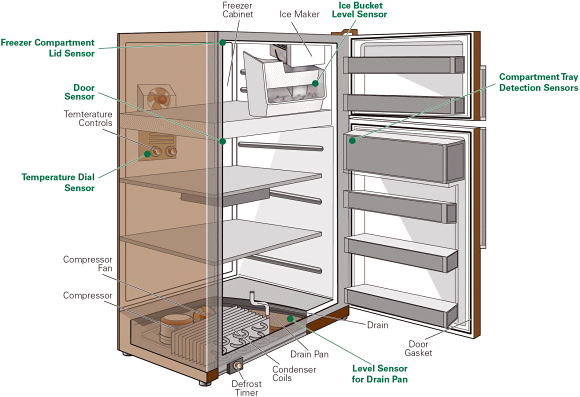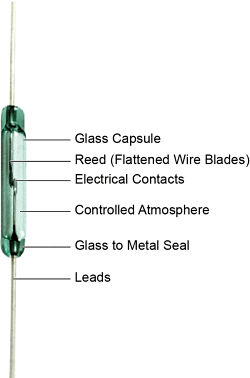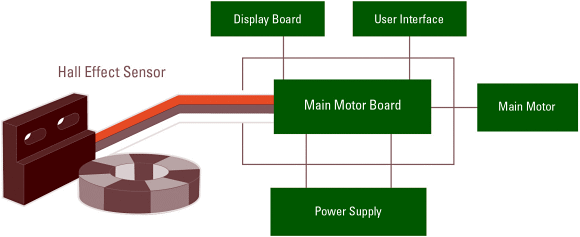
Smart technology is an integral part of many of today's consumer electronic devices. Within the home appliance market, a growing number of smart appliances are incorporating sensors to enable advanced sensing and control. Sensor technologies for position, proximity, level, flow and speed controls are being used across a broad array of appliances to deliver improved accuracy, reliability and efficiency. Modern smart appliance designs require multiple sensors in each unit as shown in figure 1.

Fig. 1: Diagram of a refrigerator showing various locations of sensors.
What's driving the application of sensors in the appliance industry? This article will consider the top four factors, including the introduction of microprocessor control systems in appliance designs. Then, it will highlight two examples of noncontact (touchless) sensing technologies and their impact on home appliance designs.
Four Factors Impacting Appliance Sensor Applications
- The demand for consumer convenience and home automation are driving the need for household appliances with smart sensors. As modern homes become more dependent on smart technology, smart appliances with advanced sensors will be in the best position to support future smart home infrastructures, enabling synchronized communication and control.
- Worldwide demand continues to grow in Asia, South America, and other continents for low-cost appliances with improved efficiencies and energy savings.
- Soaring energy prices and government regulations demand energy-efficient appliances. The use of sensors in multiple applications, including smart power grids, smart buildings and smart industrial process control, helps enable a more efficient use of resources and a reduction in greenhouse gas emissions. Modern appliances with built-in efficiencies from advanced sensors dramatically reduce the required levels of energy/water and minimize the amount of waste fluids for disposal.
- The use of microprocessor control systems has reduced the need for large mechanical contactors/relays and switching technologies that traditionally switched several amps and incandescent light bulbs. Today's smart appliances require low-voltage and low-current switching/sensing devices. Noncontact sensing devices are ideal for replacing the mechanical units. The next section will consider some examples and their application in the appliance market.
Noncontact Sensors: Reed Switch and Hall Effect
Reed switches and Hall Effect sensors are noncontact sensing technologies that are suitable for millions of operation cycles. They are considered noncontact because the activating device does not have to make physical contact with the sensor to change the sensor output. We will now discuss key details about reed switches and Hall Effect sensors and how these devices impact today's home appliance designs.
Reed Switches
A reed switch is an electrical switch operated by an applied magnetic field. As a passive component, it does not require any power to operate. The switch consists of two or three thin metal pieces called reeds with plated contacts at their tips that are spaced a small distance apart (see figure 2). The reeds are usually enclosed in a sealed glass tube filled with inert gas.
 Fig. 2: Components of a reed switch. |
Because of its simplicity and reliable performance, the reed switch is ideal for low-power applications such as home appliances. Reed sensors are often used in a refrigerator or oven door to detect when the door is open or closed. The sensor sends a signal to the control unit to promptly activate or deactivate the LED in the appliance.
The magnetic sensitivity switch points of reed switches are more precise than solid-state digital switches. High accuracy is especially vital when designing the system to function under all operating conditions. Since the reed switch contacts are hermetically sealed, they are protected from the extreme temperatures, humidity, and moisture found in many appliances without impacting their contact stability or operating life.
Hall Effect Sensors
Hall Effect sensors are semiconductor-based transducers that vary the output voltage in response to changes in the magnetic field. These sensors combine a Hall Effect sensing element with circuitry to provide a digital on/off or analog output signal that corresponds to the change of a magnetic field without involving any moving parts.
Unlike a reed switch, a Hall Effect device contains active circuitry that draws a minute amount of current at all times (see figure 3). Hall Effect sensors are programmable and can be used in a variety of ways to obtain multiple outputs, including digital, analog and speed sensing.

Fig. 3: Washing machine drum speed Hall Effect sensor with ring magnet.
Hall Effect sensors are quite popular in washing machine speed sensor applications. The rotational speed of the machine tub is monitored by a multipole magnet — 16 or 32 poles — that is attached to the motor shaft. The magnet rotates over a Hall Effect sensor with excellent speed measurement capabilities. This digital speed signal is sent to the control unit that internally controls the motor speed for the various speed cycles.
How Noncontact Sensors Improve Today's Appliances
To compete in today's smart-appliance market, designers must take advantage of every technology at their disposal, including noncontact sensors. These sensors will enhance the performance and appearance of the appliance design, which leads to increasing consumer satisfaction and demand. In addition to the energy savings associated with microprocessor controls, other improvement benefits include the enhanced reliability and reduced maintenance costs when using noncontact sensors when compared to mechanical technology.
Increased Accuracy
Output signal options for noncontact sensors include digital signals for position sensing and ratio-metric output values for linear or rotational sensing. These signals can deliver instantaneous values, which enable tighter controls and better resolution for enhanced sensing accuracy.
Added Flexibility and Reliability
With noncontact sensing technologies, appliance designs are much more flexible for applications requiring tight tolerances. This is especially important in confined areas where the space available for mounting sensors is very limited.
Noncontact sensors deliver improved reliability and durability over the life of the appliance because they are unaffected by mechanical wear or oxidization buildup on the mechanical contacts. In addition, these sensors are protected from changes in temperature or moisture that are common in many household appliances.
Improved Energy Efficiency
Noncontact sensing solutions help deliver the energy efficiencies needed for household appliances to earn the ENERGY STAR rating. The increased use of ENERGY STAR appliances has had a positive effect on the environment. Consider the following facts:
- The EPA estimates that ENERGY STAR products prevent over 150 million metric tons of greenhouse gas emissions each year.
- These products save more than 200 billion kilowatt-hours of electricity per year—which is 15 percent of U.S. residential use.
- The ENERGY STAR program has resulted in billions of dollars in savings on energy usage since its inception in 1992.
Enhanced Aesthetic Appeal
Unlike mechanical devices that have visible levers or push-buttons, the sensor and magnet actuators of the noncontact technologies are hidden behind the appliance panels. This results in more sleek, attractive design that modern customers prefer.
Conclusion
The growth of the smart appliance market has triggered a demand for advanced sensor technologies. The use of microcontrollers, increases in home automation, rising energy prices and the global demand for low-cost appliances have helped position noncontact sensors in the home appliance market. Low-power, noncontact sensors such as reed switches and Hall effect sensors are delivering flexible sensing solutions with tighter tolerances. These advanced sensors are enabling more reliable, durable and attractive appliance designs that have a lower impact on the environment.
About the Author
Gwenn Gmeinder is the North American Business Development Manager for sensor products within the Electronic Business Unit at Littelfuse. For over 30 years, he has worked with sensor technologies at several companies. Gmeinder earned his BS in industrial technology from the University of Wisconsin-Stout. He can be reached at [email protected].
Related Stories
ZigBee MCU SoC to Advance Smart Home and IoT Innovations
IoT Platform Industry's First to Offer Full HomeKit Support to Hardware Manufacturers
NEW 3-D INSPECTION SOFTWARE FOR INTUITIVE CONTACT AND NON-CONTACT MEASUREMENT